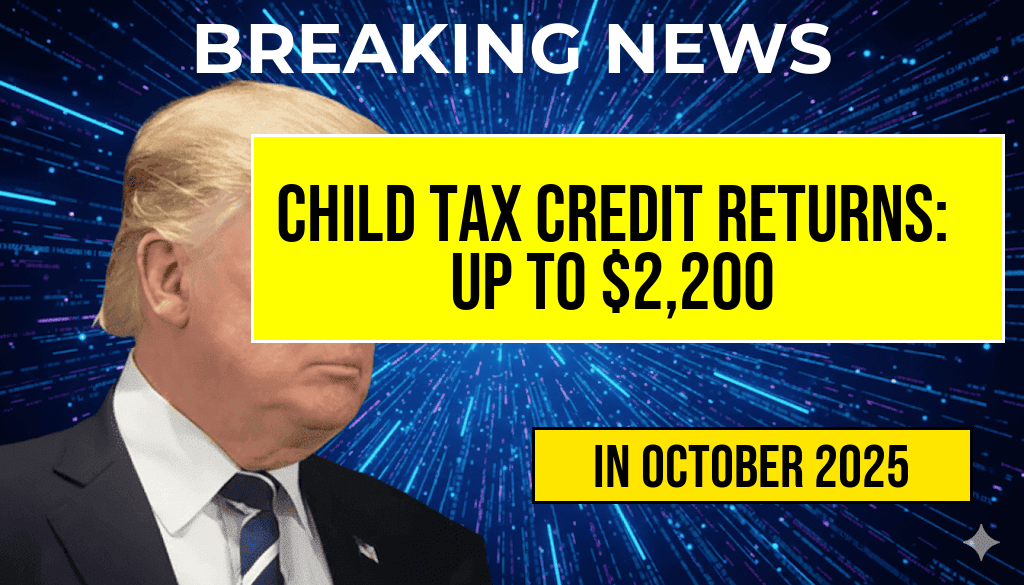The Child Tax Credit (CTC) is returning to its previous enhanced structure, providing eligible families with substantial financial support starting next year. Under the updated program, families can receive up to $2,200 per qualifying child, a significant increase from previous years when the amount was lower. This adjustment aims to assist millions of American households facing rising living costs, especially those with children. The new provisions are part of broader efforts to reduce child poverty and support economic stability for working families. Eligibility criteria have been clarified, and new phases of implementation will be rolled out through the IRS, which administers the credit. As the 2024 tax season approaches, families are encouraged to review their eligibility and prepare necessary documentation to claim the maximum benefits available. This revamped Child Tax Credit reflects ongoing federal commitment to child and family welfare, with detailed guidelines available on official IRS resources.
Understanding the Updated Child Tax Credit for 2024
What Families Can Expect
The 2024 Child Tax Credit offers qualifying families up to $2,200 per child under age 17. This amount is an increase from the previous year’s maximum of $2,000, with adjustments for inflation ensuring that the credit remains impactful. The credit is designed to help offset expenses related to raising children, including education, healthcare, and daily necessities. Unlike the temporary enhancements introduced during the COVID-19 pandemic, the upcoming structure is set to provide consistent support throughout the year, with some key modifications to eligibility and payment procedures.
Eligibility Criteria and Income Limits
| Criteria | Details |
|---|---|
| Child’s Age | Under 17 years old at the end of the tax year |
| Relationship | Biological, adopted, stepchildren, or foster children |
| Residency | Must reside with the taxpayer for more than half the year |
| Income Limits | Phaseouts begin at $200,000 for single filers and $400,000 for married filing jointly |
| Taxpayer Income | Adjusted gross income (AGI) below phaseout thresholds |
Families earning above these thresholds will see their credit gradually decrease, ensuring that the benefit targets lower- and middle-income households most in need.
How to Claim the Child Tax Credit
To receive the full benefit, eligible families should file their taxes using IRS Form 1040 and include the Child Tax Credit information. The IRS will automatically determine eligibility based on the information provided and will process the payments accordingly. For families who do not usually file taxes, the IRS has provisions to claim the credit through simplified procedures, ensuring broader access to support.
Comparison of Previous and Current Child Tax Credit Benefits
| Aspect | 2022 | 2024 |
|---|---|---|
| Maximum Credit per Child | $2,000 | $2,200 |
| Age Limit | Under 17 | Under 17 |
| Refundability | Partial, up to $1,400 | Enhanced, fully refundable up to $2,200 |
| Income Phaseout Threshold | $75,000 (single), $150,000 (joint) | $200,000 (single), $400,000 (joint) |
The increased thresholds and full refundability are designed to make the credit accessible to a broader range of families, particularly those with lower incomes.
Impacts on Families and Broader Policy Goals
Financial Relief and Child Poverty Reduction
According to recent analyses, expanding the Child Tax Credit has contributed to significant declines in child poverty rates during its temporary enhancements. Advocates argue that restoring and expanding these benefits helps stabilize household finances, improves child health outcomes, and supports educational opportunities. The increased maximum benefit ensures families can better manage costs associated with child-rearing, especially amid inflationary pressures.
Federal Policy and Future Outlook
Government officials emphasize that the return of the expanded Child Tax Credit aligns with ongoing efforts to create a more equitable social safety net. Budget allocations and legislative actions suggest a sustained commitment to supporting families, with discussions about further enhancements often on the policy agenda. Experts suggest that these benefits, if maintained and expanded, could contribute to long-term economic growth by fostering healthier, more secure childhoods.
Resources and Assistance
Families are encouraged to consult IRS guidelines and seek assistance from tax professionals if needed to maximize their benefits and ensure compliance with all requirements.
Frequently Asked Questions
What is the Child Tax Credit for next year?
The Child Tax Credit for next year allows eligible families to receive up to $2,200 per child, providing financial support to help with child-related expenses.
Who is eligible to receive the Child Tax Credit?
Eligible families must meet certain income and qualification criteria, including having dependent children under age 17 and meeting filing requirements.
How much can I receive per child with the Child Tax Credit?
Families can receive up to $2,200 per child for the upcoming year, which may be partially refundable depending on your income and tax situation.
When will the Child Tax Credit payments be available?
The Child Tax Credit payments are scheduled to be available starting next year, with details on payment dates and distribution methods provided by the IRS.
How do I apply or claim the Child Tax Credit?
To claim the Child Tax Credit, you need to file a federal tax return and ensure that your dependent information is accurate on your return. Additional eligibility details can be found on the IRS website.

Leave a Reply